Kerala’s Tribal Education: Inclusive Learning for Cholanaikkans
Why in the News?
Samagra Shiksha Kerala has developed audio-visual educational materials in the Cholanaikkan tribe’s Dravidian language to educate a bedridden tribal girl. This initiative promotes inclusive learning, cultural preservation, and empowerment for one of India’s most isolated and endangered communities.
Bridging Education Gap for a Tribal Student:
- Samagra Shiksha Kerala, under the general education department, introduced an innovative learning approach for a bedridden girl from the Cholanaikkan tribe.
- To ensure accessibility, 30 audio-visual educational materials were specially created in the tribe’s unique Dravidian language.
- This initiative promotes inclusivity, cultural sensitivity, and educational equity for vulnerable communities.
Impact on Education and Cultural Preservation:
- The initiative enhances educational accessibility while preserving the tribe’s language and heritage.
- It underscores the importance of culturally adaptive education for marginalized groups.
- By integrating technology and linguistic inclusivity, Samagra Shiksha Kerala is fostering empowerment through education.
- This model can serve as an inspiration for other tribal education programs, ensuring no community is left behind.
Cholanaikkan Tribe: Kerala’s Endangered Indigenous Community
- Known as the “Cavemen of Kerala”, the Cholanaikkans are one of India’s most isolated and endangered tribal groups.
- With a population of less than 400, they are classified as a Particularly Vulnerable Tribal Group (PVTG).
- They inhabit the Karulai and Chungathara forest ranges in Nilambur, Malappuram district, deep within the Western Ghats.
- The community continues a forest-based lifestyle, relying on natural resources rather than agrarian or urban practices.
- They still reside in natural caves, preserving their traditional way of life.




